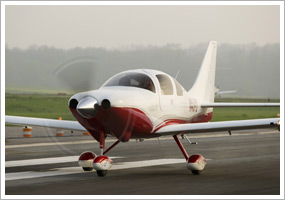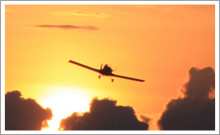Aug. 12, 2011, issue of 'AOPA ePilot: Flight Training Edition' newsletter
|
|
| ||||
| | FT News | INSIDE AOPA | TRAINING PRODUCTS | FINAL EXAM | |||
TRAINING TIPs ‘The runway behind you’ It’s even worse if your own technique was responsible for the runway being where you can’t use it. For takeoffs, the economical choice is also the safe choice: Don’t waste runway! Many pilots routinely squander surface for no good reason. Complacency is often the culprit. Unlike short-field departures, normal takeoffs place no special emphasis on using all available runway. Bad habits result. Lining up for takeoff, many pilots let the aircraft creep forward—sometimes, well forward—while they fiddle with dials or knobs. Following the leisurely alignment, the pilot only gradually powers up for takeoff as the aircraft rolls along, gobbling precious runway. A better approach is to find a way to use maximum available takeoff area under all takeoff circumstances—especially under high-density-altitude conditions or when you must make an intersection takeoff. How much runway is actually available for takeoff? Check runway-distance-remaining signs. Remember, when taking off from a runway with a displaced threshold, that the displacement reduces runway available for landing—but not for the takeoff. Know your aircraft’s takeoff performance, and always build in a healthy margin of error. Attention to small details can pay large dividends. That’s what pilots practicing max-performance takeoffs and landings on just a few hundred feet of gravel are safely learning this summer under a program in Alaska. Follow up your runway-conserving takeoff with a disciplined climb at best-rate-of-climb speed (V Y) to a safe maneuvering altitude. Focus on applying the private pilot practical test standard of maintaining airspeed of V Y plus 10 knots or minus 5 knots to your climb. As for that old saying about the three most useless things for a pilot: It has many variations. Musician Aaron Tippin offered one arrangement, giving some advice to student pilots in the January 2011 Flight Training’s “Debrief” column. Learn the lyrics, and stay safe! YOUR PARTNER IN TRAININGAs an AOPA member, you have online access to articles from AOPA's flagship publication, AOPA Pilot. Simply go to the AOPA Pilot archives for a wealth of information, organized by subject. You'll find training information, safety articles, legal issues, aviation careers, and more. Take advantage of this additional AOPA membership benefit to get the most from your training.
Did you know that student pilots who join AOPA are three times more likely to complete their flight training? Membership includes unlimited access to aviation information by phone (800/USA-AOPA, weekdays from 8:30 a.m. to 6 p.m. Eastern time) or from Flight Training Online or AOPA Online. If you're not already a member, join today and get the pilot’s edge. Login information is available online. FLIGHT TRAINING NEWSAirplane stolen from Alabama flight schoolA flight school based at Jack Edwards Airport in Gulf Shores, Ala., reported a Piper Cherokee stolen on Aug. 1. The airplane departed with one pilot and full fuel, according to Nola.com. Air traffic controllers last saw it 100 nautical miles southeast of New Orleans, over the Gulf of Mexico, but no signs of a downed aircraft or debris have been found. If you see suspicious activity at your airport, report it at 866/GA-SECURE (866/427-3287). Find more tips on securing your airport at AOPA Online. Challenge yourself with safety quiz“It can’t happen to me.” Fuel-related accidents are among the most preventable aviation mishaps, yet otherwise competent pilots continue to turn perfectly good airplanes into impromptu gliders at a surprising rate. Are you at risk? The Air Safety Institute’s latest safety quiz, sponsored by the AOPA Insurance Agency, will help you find out. Take the quiz >> FltOps.com to host regional airline job fairsFltOps.com will host regional airline pilot job recruitment fairs on Aug. 27 in Chicago and Sept. 24 in Los Angeles. The job fairs are open to registered FltOps.com members. Accompanying “Focus on the Future” sessions, which will explore careers in aviation, are open to parents, students, and counselors, and are free. For more information, see the website or call 800/538-5627. Passenger briefing course to guide pilotsA new pilot eagerly awaits the chance to take up a passenger. Do you know what you will say when it’s time to brief your cockpit guest? In response to a recommendation from the National Transportation Safety Board, the Air Safety Institute is creating a short training video to coach pilots on how to give an effective passenger briefing on emergency communications and survival equipment. Read more >> Eastern Kentucky U assumes management of airportEastern Kentucky University took over management of Madison Airport in Richmond, Ky., on Aug. 4. The university bases its aviation program at the airport and is the facility’s largest user, according to The Richmond Register. The university will manage the airport under a one-year contract with the option to renew another two years. Inside AOPANew Webinar takes an in-depth look at cockpit weatherDoes your training airplane have the capability to display weather data? Datalink has taken a lot of the uncertainty out of weather flying, but using it safely means more than just counting on radar to steer you through whatever nature decides to dish out. Join AOPA Foundation President Bruce Landsberg and NEXRAD datalink expert David A. Strahle on Wednesday, Aug. 24, for a must-see discussion of how you can use cockpit weather to complete more trips and minimize your weather risks. Register online >> Get a sneak peek at the new AOPA Holiday OrnamentGet into the holiday spirit early this year with the 2011 limited edition AOPA Holiday Ornament. The 1940 Waco, offering its nostalgic glimpse of aviation times gone by, is certain to inspire you to share your most cherished aviation memories. The 2011 AOPA Holiday Ornament is now available at the AOPA Store. Every purchase made at the AOPA Store benefits the association’s work preserving and protecting your right to fly. Be pro-active with your health careAs an AOPA member, you have access to easy, accurate, and affordable health screenings that take place at more than 20,000 screening sites nationwide. In a little more than an hour, you can be screened with painless, non-invasive, ultrasound technology for strokes, aneurysms, and heart disease. A variety of health screening packages are available at a discount, and you simply select the package that’s right for you. For more information or to locate a screening center near you, visit the AOPA page at Life Line. TRAINING PRODUCTSVOR-At-A-Glance flash cards from Aircraft SpruceVOR: the navigational aid that everybody loves to hate. Whether you’re trying to master them or studying for a knowledge test or checkride, you must understand how to interpret them. VOR-At-A-Glance flash cards from Aircraft Spruce will help you to read course, radial, and location information at once. The retail price is $36.75. Order online or call 877/477-7823.
Note: Products listed have not been evaluated by ePilot editors unless otherwise noted. AOPA assumes no responsibility for products or services listed or for claims or actions by manufacturers or vendors. FINAL EXAMQuestion: I’m based at a nontowered airport and I’d like to know the difference between the departure leg and the upwind leg.
Answer: The Aeronautical Information Manual addresses this question in Chapter 4, Section 3, Airport Operations. The upwind leg runs “…parallel to the landing runway in the same direction of landing. The departure leg begins after takeoff and continues straight ahead along the extended runway centerline.” So the main difference between the two is that the upwind leg is parallel to the runway whereas the departure leg is along the extended runway centerline. For more information on flying at nontowered airports, see the Air Safety Institute Safety Advisor Operations at Nontowered Airports .
Got a question for our technical services staff? Email [email protected] or call the Pilot Information Center, 800/872-2672. Don’t forget the online archive of “Final Exam” questions and answers, searchable by keyword or topic. AOPA Career OpportunitiesEver dream of turning your passion for aviation into a career? We’re looking for an application support engineer, .Net developer, electronic advertising manager, and manager of airspace and modernization. To learn more about other AOPA career opportunities, visit AOPA Online. Picture Perfect AVIATION EVENTS & WEATHER To include an event or to search all events in the calendar, visit AOPA Online. For airport details, including FBO fuel prices, see AOPA Airports. Flight Instructor Refresher ClinicsThe next Air Safety Institute Flight Instructor Refresher Clinics are scheduled in Long Beach, Calif., and Allentown, Pa., Aug. 13 and 14; Champaign, Ill., and Reno, Nev., Aug. 20 and 21; Phoenix, Ariz., and Bellevue, Wash., Sept. 10 and 11; and Sacramento, Calif., Colorado Springs, Colo., and Richmond, Va., Sept. 17 and 18. For a complete schedule, see AOPA Online.
Can’t make it in person? Sign up for the CFI Refresher Online. Air Safety Institute Safety SeminarsAir Safety Institute Safety Seminars are scheduled in Wichita, Kan., Germantown, Tenn., Fort Worth, Texas, and Houston, Texas, Sept. 12; Bethany, Okla., Nashville, Tenn., Addison, Texas, and San Antonio, Texas, Sept. 13; Fayetteville, Ark., Maryville, Tenn., and Austin, Texas, Sept. 14; and Little Rock, Ark., Sept. 15.
Topics vary—for details and a complete schedule, see AOPA Online. | Advertisers Got news? Contact ePilot. Having difficulty using this service? Visit the ePilot Frequently Asked Questions now at AOPA Online or write to [email protected]. |
| Member Tools : Send feedback | ePilot Archive Editorial Team: ePilot Flight Training Editor : Jill W. Tallman | ePilot Editor: Sarah Brown | Contributor: Alton K. Marsh |

 An old saying reminds pilots that one of three things of no use to a pilot is “the runway behind you.”
An old saying reminds pilots that one of three things of no use to a pilot is “the runway behind you.”


